|
![]()
Greatest Films of the 1940s
1940 | 1941 | 1942 | 1943 | 1944 | 1945 | 1946 | 1947 | 1948 | 1949
Title Screen Film Genre(s), Title, Year, (Country), Length, Director, Description 


Abe Lincoln in Illinois (1940), 110 minutes, D: John Cromwell
This screen adaptation was based upon Robert E. Sherwood's 1939 Pulitzer Prize-winning play, yet was slightly inferior to the previous year's Young Mr. Lincoln (1939) by director John Ford and starring Henry Ford. It was an historically accurate and realistic portrayal of Abraham Lincoln's (Raymond Massey, reprising his 1938 Broadway stage impersonation and future signature role) life as small-town resident, suitor, lawyer, legislator, and as the 16th President (and Great Emancipator) beginning in 1860. The film opened with Lincoln's poor childhood in the backwoods of Illinois, following his early career as a clerk in a shop in New Salem, Illinois, his ill-fated love for Ann Rutledge (Mary Howard) who was already engaged and then died tragically in 1835, his reluctant decision to run for political office for the first time as a Whig Party state assemblyman (and serve a single term), his short stint as a self-educated lawyer in Springfield, Illinois, his on-again, off-again relationship with ambitious Mary Todd (Ruth Gordon in her debut film role) and their eventual marriage in 1842, his election to a single two-year term in Congress (1846-48), his memorable debates (the highlight of the film) as a Republican candidate against political rival Senator Stephen Douglas (Gene Lockhart) who defeated Lincoln and won the Senate seat in 1858, and Lincoln's election to the Presidency.



All This, And Heaven Too (1940), 140 minutes, D: Anatole Litvak
Director Anatole Litvak's elaborate, overly-long melodramatic,19th century period production from Warner Bros. (with a lush score by Max Steiner) was set in France, and based upon Rachel Lyman Field's 1937 best-selling novel about a scandalous, notorious and tragic real-life murder case in Europe. [Note: Authoress Rachel Field was character Henriette's grand-niece.] In the lurid but poignant marriage-drama story and costume drama, aloof and philandering French nobleman Duc de Praslin (Charles Boyer) hired Henriette Deluzy-Desportes (Bette Davis) as a governess for his four children in 1846. Henriette was initially presented as self-reliant, composed and quietly dignified. While employed, the tormented Duc presumably entered into a loving relationship with the governess (although they never even touched each other in the film), while his sultry, crazed and cold wife Duchesse de Praslin (Barbara O'Neil) became insanely jealous, emotional and resentful of the kindly and loving Henriette and the affair she thought was occurring (and being gossiped about), although she was uncaring and abusive with her own four children. Henriette was fired from her governess position, due to the Duchesse's vindictive nature, and vengefully denied a letter of recommendation, leaving Henriette unemployed and impoverished. The debonair Duc and his governess became prime suspects after the Duchesse was found murdered in 1847 (hacked to death in her bedroom) - and Henriette was considered the Duc's accomplice. The Duc was placed in custody in his own home (due to his position, he couldn't be arrested), while Henriette was charged with the crime and jailed. To save her and the French government (because of his associations with the French king Louis-Philippe) from further embarrassment, and knowing that a trial was imminent, the Duc assumed full responsibility for the crime with a deathbed confession after suicidally taking strychnine poison. Without admitting anything in particular, the Duc only claimed that Henriette was innocent. After the exoneration and an acquittal, Henriette was released from prison without evidence to hold her. When the French king was overthrown, she fled from France and emigrated for refuge to the US (where she told her story of 'de Praslin affair' in flashback, as the infamous 'Mademoiselle D') as a French teacher (using an assumed name) in NY's Miss Haines School. After listening to her tragic confessional story, her initially-hostile students became sympathetic and forgiving toward her.


Angels Over Broadway (1940), 79 minutes, D: Ben Hecht and Lee Garmes
Co-director Ben Hecht's and Columbia Studios' film-noirish, shadowy crime-caper drama received one Academy Award nomination for Hecht's Original Screenplay. Its tagline was: "A Romance Born Between Dusk and Dawn!" In the opening of the somber, dialogue-rich character study about a group of losers, lowlifes, nobodys and hustlers, the setting was the Pigeon Club, a swanky Broadway nightclub-cafe in NYC. On a rainy night, an embezzler Charles Engle (John Qualen) was on the verge of committing suicide (he had written a suicide note stashed in his coat pocket), and was drinking heavily. He had stolen $3,000 from his boss Hopper (George Watts) to finance his high-spending frivolous wife, who then cuckolded him. The very desperate man had only a few hours (until 6 am) to pay back the money before being charged with the crime. Another major character was Bill O'Brien (Douglas Fairbanks, Jr.), a two-bit 'wise-guy' hustler, con-man and aspiring gangster who misinterpreted Engle's excessive tipping as a sign that he was a wealthy but eccentric rich out-of-town yokel who would be an easy, victimized scam-target in a card game set up by his go-to connection - gangster-killer Dutch Enright (Ralph Theodore). A third character was once-famous, disillusioned, down-on-his-luck alcoholic playwright Eugene "Gene" Gibbons (Thomas Mitchell), who called himself a "veteran corpse" who was in the midst of a divorce and other misfortunes: ("I have written three bad plays in a row, and next year I'll write a worse one. I have neither a home, a single hope, nor a shred of curiosity left. Bankrupt and broke, I've destroyed myself, sir, in becoming famous. I am no longer a man, Mr. Engle, I'm an epitaph over an ash can!"). A fourth individual - pretty and alluring Nina Barona (22 year-old Rita Hayworth in her first major lead role) was an unemployed, aspiring ballet dancer working at the club as a showgirl. Together, Nina, Gibbons, and O'Brien idealistically schemed to help or "save" Engle. Gibbons was inspired to script a new and 'happy ending' for Engle's life. They temporarily entered him as "bait" into Enright's high-stakes fixed poker game to fleece him, but just long enough so that he would win the $3,000 (regarded as initial "sucker money") he needed, and then drop out, and reimburse his boss' stolen funds. Due to a series of misadventures, just before going through with the plan, Gibbons went home to his estranged wife before the game began, and Dutch learned of the devious plan. Nina and O'Brien continued to pursue their scheme to win the money for Engle. She convinced O'Brien to appeal to his better side and beat off Dutch's gambling thugs while Engle escaped down a fire escape with the money. In the final scene, Nina and O'Brien were brought together and falling in love - as she complimented him on his changed nature: (Nina: "Something wonderful happened tonight. l'll remember it for a long time. Oh yes, when things don't seem so wonderful, l'll, I'll remember Mr. Gibbons, Mr. Engle - and you. And that people aren't really mean. They can be better than they are if they want. lf they'll let themselves. Even if it doesn't last. They can be better than they are"). They clenched and kissed on the street at the dawning of a new day.

The Bank Dick (1940), 73 minutes, D: Eddie Cline
W.C. Fields appeared in his last major film role in this classic comedy, with wonderful bumbling sight gags and hilarious one-liners. He credited himself as screenwriter Mahatma Kane Jeeves (similar to "My hat, my cane, Jeeves!"). As Egbert Souse (W. C. Fields) (pronounced "Soo-zay"), he was a drunken, unemployed, no-account, henpecked, child-hating husband living in Lompoc, California (pronounced Lompoke). His family who often complained: "House just smells of liquor and smoke," included his cranky mother-in-law Mrs. Hermisillo Brunch (Jessie Ralph), his younger daughter Elsie Mae Adele Brunch Souse (Evelyn Del Rio), and his nagging wife Agatha Sousé (Cora Witherspoon). The lush barfly often escaped from his family by sneaking out to the Black Pussy Cat Cafe for stiff drinks, where he performed a drinking routine in front of bar proprietor Joe Guelpe (Shemp Howard, one of the replacement Three Stooges); he dipped his fingers in a glass of water, dried them with a paper napkin that he crumpled and rolled into a ball, then tossed it into the air over his shoulder and neatly kicked it away with the heel of his shoe, followed by a burb and cough. To his family's astonishment, he had the opportunity to direct an on-location movie in town (to replace drunken director A. Pismo Clam (Jack Norton)). After his chair toppled backwards off his majestic perch on the platform, his bratty young daughter Elsie Mae approached, pulled on his coat tails, and demanded a part in the picture: "I wanna be in the picture (he deferred her request by patting her on the head)...What's the matter, Pop? Don't ya love me?"; when Egbert went to slug her, Cora threatened: "Don't you dare strike that child!" - to which Egbert replied: "She's not gonna tell me I don't love her!" He also inadvertently foiled a bank robbery in town for allegedly capturing Loudmouth McNasty (George Moran), one of two bank robbers with the money, and was rewarded for his accidental heroism with a free bank calendar and an in-bank position as a guard (or "dick"-detective) by grateful Lompoc State Bank president Mr. Skinner (Pierre Watkin). Egbert met with the pompous Mr. Skinner to be congratulated on his daring, gallant deed: "And I wish to personally give you a hearty handclasp." Skinner avoided shaking Sousè's outstretched limp-wristed hand, barely touching the tips of his fingers to his palm. Egbert also concocted an ill-advised embezzlement plan (with the complicity of his future, dim-witted son-in-law Og Oggilby (Grady Sutton), a bank clerk and the fiancee of his lovesick oldest daughter Myrtle (Una Merkel)) to temporarily "borrow" or steal $500 from the bank (until he could repay the money with Og's bonus due in a few days) to invest in worthless stock in the questionable and flimsy mining operation known as the Beefsteak Mining Company - offered by charlatan con J. Frothingham Waterbury (Russell Hicks). To convince Og, Egbert told him: "Surely, don't be a luddie-duddie, don't be a moon-calf, don't be a jabbernow, you're not those, are you?" During Egbert's work as a vigilant bank security dick - he choked a young boy in a cowboy outfit waving a toy gun - believing that he was a holdup man - as the bratty boy walked out of the bank, he ridiculed the guard's shiny, bulbous red nose: "Mommy, doesn't that man have a funny nose?" His mother chided him for making fun: "You mustn't make fun of the gentleman, Clifford. You'd like to have a nose like that full of nickels, wouldn't you?" Souse used knock-out Mickey Finn drinks to hold off effeminate, prissy, inquisitive and persistent bank examiner/auditor J. Pinkerton Snoopington (Franklin Pangborn) - who was suspicious of Egbert's financial dealings. As it turned out, the Beefsteak Mine stock was actually valuable, and Waterbury urged Egbert to resell him the shares, but before the transaction could occur, the second uncaught bank robber Repulsive Rogan (Al Hill) returned to rob the bank of mining stock and cash, and took Egbert "hostage." He was forced to drive the getaway car, with the robber in the back seat. It was a memorable, zany, slapstick car chase scene - a superbly-timed chase amongst multiple cars (Souse's car was followed by the local police, the bank president, and a representative from the movie company) that zoomed and circled around, barely avoiding crashing into each other or other obstacles in the path. The getaway car careened through streets, over ditches (over the heads of ditchdiggers), around curves and up a mountainside, missing collisions at every turn with the pursuit vehicles. When asked by the thug in the back seat to give him the wheel, Egbert matter-of-factly pulled it off the steering column and gave it to him. After the robber was struck unconscious by a tree branch and apprehended, Sousè was an unlikely hero once again for thwarting another heist. This time, he received $5,000 for capturing the thief, and a film company bought his story for $10,000 - funds he used to purchase a top hat and tails, and a new mansion, before returning for a visit to the Black Pussy Cat Cafe.


Boom Town (1940), 116 minutes, D: Jack Conway
Director Conway's and MGM's exciting action and western drama was based upon James Edward Grant's short story "A Lady Comes to Burkburnett" that first appeared in Cosmopolitan magazine. It marked the third and final pairing of two iconic MGM stars: Gable and Tracy. The story involved a turbulent cycle of partnerships and breakups between two oil-men over their love for the same woman during a 20 year period. It opened in 1918 in a W. Texas oil town during a gunfight, where the two western wild-catters were introduced in their hotel: tough and cocky "Big John" McMasters (Clark Gable) and "Square John" Sand (Spencer Tracy), aka "Shorty." They were bestowed with their nicknames by the town's saloon girl Whitey (Marion Martin). The two down-on-their-luck men became reluctant partners, and joined together to steal oil drilling equipment from company owner Luther Aldrich (Frank Morgan), to use for their own oil-drilling venture that turned out to be a salt-water bust. Forced to flee and travel to various oil-drilling sites for employment, the men made enough through wild-catting (and McMasters' gambling luck) to partially repay Aldrich. As part of a deal to reimburse Aldrich, they offered him 1/8th of their profits if their new well struck it rich. A new character, quick-witted Eastern-bred schoolteacher Elizabeth 'Betsy' Bartlett (Claudette Colbert) showed up, and spurred competition between them for her heart. Although Betsy was Sand's longtime hometown girlfriend, she married McMasters - something that Sand reluctantly permitted in order to keep his friendship. Throughout the film, the two men went through various periods of boom and bust. After a year of marriage, Betsy (accompanied by Sand) caught her drunken husband dancing with barroom floozy Whitey, and decided to leave him. A quarrel between the two alienated men Sand and McMasters ended with a coin-toss for ownership of their oilfields. Sand won the bet, forcing Betsy to forgive her disgraced husband and return to him - although he was no longer permitted on the premises. Fortunes would again change when Sand became a drunkard and sold out his entire business to Aldrich. He moved to the tropics of Latin America, where he again crossed paths with the itinerant, unemployed McMasters and Betsy, who now had a young son named Jack. Their petty squabbles were interrupted by a Latin American revolution that set fire to Sand's oil wells, and he lost everything. In the continuing saga of their ups-and-downs fortunes, McMasters became successful on land bought in Oklahoma, and then decided to expand eastward to New York and become involved in oil distribution. As a rich oil baron, he became associated with femme fatale Karen Vanmeer (Hedy Lamarr), an advisor to his slick former customer Harry Compton (Lionel Atwill), who used her sexy wiles to provide Big John with industrial secrets about his rival competitors. McMasters began to spend all his time with Karen and neglect his family. Although Sand lost everything in Latin America, he struck in rich in Oklahoma. Eventually, the two men were reconciled at an oilmen's convention and they began to work together again. Sand suspected that the long-suffering Betsy was unhappy with her unfaithful husband McMasters due to the presence of Karen. He proposed a loveless marriage to Karen to remove her from McMasters' life, but she rejected his idea and vowed to ultimately marry McMasters. Meanwhile, Betsy attempted a suicidal drug overdose. Sand took an alternative approach to ruining Big John. He teamed with Compton and tried to bankrupt his former partner's illegal monopolies, but his efforts backfired and he went broke, although McMasters lost $5 million. In the conclusion, the two men engaged in a brawling fist-fight after Sand asked McMasters to give his wife a divorce. Karen realized that she was causing a rift and decided to leave McMasters. McMasters was brought to trial by the government for violating the Sherman Anti-Trust Act, and was defended by his old pal, but still lost his fortune. However, starting over again, Sand and McMasters teamed up in a new wild-catting venture in Kettleman Hills, CA - and ultimately would become very rich.


Dance, Girl, Dance (1940), 90 minutes, D: Dorothy Arzner
An early feminist-minded film, and a critical and commercial box-office failure, this musical drama was directed by one of the few female Hollywood directors at the time - pioneering butch-lesbian Dorothy Arzner (it was regarded as her best film). It also featured one of Lucille Ball's better film roles. It was not to be confused with the 1933 film of the same name. This backstage musical was taglined: "Heartbreak Behind Gayety of a Girly-Girl Show!" and pitted the two dichotomous female leads against each other - a good girl vs. bad girl representing two opposite styles of dance (burlesque and ballet). Aspiring 'serious' but poor ballerina Judy O'Brien (young Maureen O’Hara in her third Hollywood film) - an Irish redhead, and her outrageous, gold-digging, ambitious friend Bubbles (Lucille Ball) were introduced as two chorus girls stranded in Akron, Ohio before they traveled separately back to New York City to find work. Bubbles (renamed "Tiger" Lily White) became a cheap burlesque stripper in a live show, while Judy struggled in dance school with her Russian dance teacher/mentor Madame Lydia Basilova (Maria Ouspenskaya). With a cruel and cutthroat gesture, Bubbles hired the desperate Judy to dance ballet immediately after her own act, knowledgeable that "stooge" Judy would be greeted with hostile jeers, boos, and laughter from the voyeuristic dirty-old-man audience, and would - of course - demand an encore by Bubbles (who only stripped to a hula skirt and bra!). Besides an on-stage catfight, the film's most remarkable sequence was Judy's celebrated lecture-speech delivered at the climax to the males of a jeering burlesque audience who were mocking her classical dance act.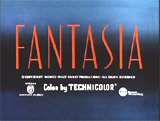


Fantasia (1940), 120 minutes, D: Ben Sharpsteen and Disney
This innovative and revolutionary animated classic from Walt Disney (his third feature animation), combined classical music masterpieces with imaginative visuals - presented with conductor Leopold Stokowski and the Philadelphia Orchestra. It was the first commercial American film to use stereophonic sound as well as the first and only film recorded in pioneering Fantasound. An updated version was created almost 60 years later, Fantasia/2000 (1999) - the first feature length animated film to be presented in IMAX, with additional animated interpretations of classical works, including Beethoven's "Symphony No. 5," Gershwin's "Rhapsody in Blue," Saint-Saëns' "Carnival of Animals," and Stravinsky's "The Firebird Suite." The eight animation sequences in this film, corresponding to classical music selections, were colorful, impressive, free-flowing, abstract, and often surrealistic pieces. They included the most famous of all: Paul Dukas' "The Sorcerer's Apprentice" with Mickey Mouse (in a comeback role) as the title character - the wizard's disobedient assistant who was battling brooms carrying endless buckets of water. Also Bach's "Toccata and Fugue in D Minor," Tchaikovsky's "Nutcracker Suite" with sugar plum fairies and dancing mushrooms, prehistoric dinosaurs and volcanoes in Stravinsky's "Rite of Spring," Beethoven's "Pastoral Symphony" with mythical Greek centaurs, cupids, and fauns, Ponchielli's delightful "Dance of the Hours" with dancing hippo ballerinas, crocodiles, ostriches, and elephants, and Mussorgsky's darkly apocalyptic "Night on Bald Mountain" with evil creatures.



Foreign Correspondent (1940), 120 minutes, D: Alfred Hitchcock
Alfred Hitchcock's second American film was this thrilling and suspenseful espionage masterpiece. A naive American police crime-reporter, Johnny Jones/Huntley Haverstock (Joel McCrea), the foreign correspondent of the title (loosely based upon real-life reporter Ed Murrow), was sent to Europe in 1939 just prior to the outbreak of war in Europe, to cover the unfolding story. He met leading peace activist Stephen Fisher (Herbert Marshall), fell for his attractive daughter Carol (Laraine Day), accidentally became involved chasing spies, and began to suspect that Fisher was part of a Nazi spy ring (masquerading as an international peace organization). Memorable scenes included the faked Amsterdam assassination scene of Dutch diplomat Van Meer (Albert Bassermann) in a crowded sea of umbrellas during a rain storm in a large public square, the mysterious Dutch windmills (Nazi hideouts) in the countryside, a murder attempt and spectacular fall at Westminster Cathedral Tower, and a thrilling trans-Atlantic ocean Clipper plane crash during which Fisher sacrificed his life after his Nazi ties were uncovered. The most memorable scenes accounted for much of the budget of $1.5 million dollars, for the visual design and recreation of the background scenery and the airplane crash effects. It was revealed by the film's end that diplomat Van Meer had been kidnapped by the Nazis (who staged his murder and had murdered an identical double), to try to extract from him a memorized secret clause 27 in an Allied treaty for his country - the film's MacGuffin. The film concluded with Jones' memorable radio speech/plea for neutrality-leaning America to join the war effort.


The Grapes of Wrath (1940), 128 minutes, D: John Ford
Director John Ford's powerful, classic socio-dramatic masterpiece was adapted from John Steinbeck's 1939 Pulitzer Prize-winning novel. It was reputedly regarded as Henry Fonda's greatest film role. It told the epic, but heartbreaking story of the perilous, Depression-Era migration of a drought-stricken, Oklahoma Dust Bowl family to the promised land of California, seeking migrant farm work during the fruit harvest. Cinematography by Gregg Toland duplicated images immortalized by documentary photographer Dorothea Lange. When they reached California, they were met with violence, prejudice, and fear, moving from one squalid campsite to the next, and were usually mistreated as migrant laborers. It included magnificent performances of the family members who were poor but honest people struggling for dignity and a better way of life, especially the idealistic son Tom Joad (Henry Fonda) and his loving matriarchal Ma Joad (Jane Darwell) (with her famed "We're the people" monologue).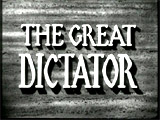

The Great Dictator (1940), 127 minutes, D: Charles Chaplin
This was actor/director Charles Chaplin's first full talking feature film in which he delivered spoken lines - a full 13 years after the advent of sound in the movies. The film was a slapstick political satire on world conditions and fascism at the start of World War II, and it was soon detested by Hitler's Third Reich. Chaplin played a dual role: as a poor and kind, unnamed Jewish ghetto barber with amnesia, and as a Hitler look-alike - the ruthless tyrannical dictator Adenoid Hynkel of the European country of Tomainia who persecuted Jews. The criss-crossing stories of the barber and the dictator eventually ended in a case of role reversal and mistaken identities. The barber won the admiration of pretty neighbor girl Hannah (Chaplin's wife at the time Paulette Goddard). Hynkel's rival was Mussolini-like Benzino Napaloni (Jack Oakie) of the neighboring country of Bacteria. Its most memorable scenes included the funny pudding-coin scene, the scene of Hynkel dancing ("pas de deux") with an inflated world globe balloon to the tune of the Overture of Richard Wagner's Lohengrin, and the competition between Hynkel and Napaloni in adjoining, ascending barber chairs, followed by a comedic food fight. The comedy concluded with a lengthy and impassioned humanistic monologue by the barber (appearing like Hynkel) about hope and human rights, and the end of tyranny.


The Great McGinty (1940), 81 minutes, D: Preston Sturges
This classic film (aka The Biography of a Bumb) debuted the talents of screwball comedy director and screenwriter Preston Sturges (with an Oscar-winning original script). The dramatic comedy took a witty, satirical, and cynical look at corrupt American politics and society, told with a stock cast of comical characters. In flashback, a banana republic bartender, Dan McGinty (Brian Donlevy) told the story of his rise from obscurity to the state governor's mansion as the result of a crooked election and lots of dirty tricks. Starting out as a dumb and homeless hobo in Chicago, he was admired by the Boss (Akim Tamiroff), head of the political machine, for his feisty nature and for stuffing the ballot box with phony votes. By playing the game crookedly, he was appointed collector of protection money, then as alderman, and through charm and more appointments, became the mayor and eventually governor (the Great McGinty). Along the way, when he cleaned up his act and became honest - there were reverse consequences. He married his divorcee secretary Catherine (Muriel Angelus) - and then fell in love with her and her ready-made family of two children, developed a social conscience, and lost it all. He suffered a political demise when he tried to go straight, fight corruption and promote real reform as governor - opposed by the Boss - and had to flee the country. [Note: Brian Donlevy and Akim Tamiroff reprised their roles as Governor McGinty and The Boss in Preston Sturges' The Miracle of Morgan's Creek (1944).]

His Girl Friday (1940), 91 minutes, D: Howard Hawks
This classic comedy was one of the earliest and best of Howard Hawks' madcap comedies with fast pacing, whirlwind, rapid-fire dialogue, and sped-up action. It was a funny and witty remake of the 1929 Ben Hecht and Charles MacArthur stage play hit The Front Page (and the subsequent film The Front Page (1931)), but switched gender roles so that the reporter was played by a woman. It was remade as director Billy Wilder's The Front Page (1974) with Jack Lemmon and Walter Matthau, and as director Ted Kotcheff's Switching Channels (1988) within a TV news environment. In the plot, newspaper reporter Hildy Johnson (Rosalind Russell) wanted to leave the paper to find a more domestic and less frantic life style, and marry mild-mannered, stuffy mama's boy insurance agent Bruce Baldwin (Ralph Bellamy). But her suave, scheming newspaper editor Walter Burns (Cary Grant), her ex-husband, wanted to keep her working as his star reporter. When a hot-breaking escaped convict/manhunt story developed and she was called upon to cover the story and write the front-page headline scoop, he attempted to win her back in a battle of the sexes.


Kitty Foyle (1940), 105 minutes, D: Sam Wood
RKO's acclaimed romantic melodrama (a classic "chick flick"), subtitled "The Natural History of a Woman," featured dancer Ginger Rogers in her first serious acting role in one of the best "women's pictures" of the 40s. It was a touching and poignant love story/soap opera, told mostly in flashback. It was adapted with a screenplay by Dalton Trumbo that was based on Christopher Morley's 1939 best-selling popular novel (which contained more racy material, including explicit sexuality and an abortion). In the plot, an ambitious, attractive white-collar working girl-secretary, Kitty Foyle (Best Actress-winning Ginger Rogers) found herself in a love triangle with a noble, but poor, idealistic and struggling doctor Mark Eisen (James Craig), and her wealthy, still-married philandering ex-husband, rich Philadelphia socialite Wynnewood 'Wyn' Strafford VI (Dennis Morgan) whom she was strangely drawn to. Her reflections on her choice of beaux (wealth vs. poverty) were told through flashback. The film also used a technique of a 'mirror-image' conscience to show two sides of Kitty's personality (the rational vs. the emotional and impulsive) during her dilemma. Caught in a difficult love triangle, she had to choose in the final scene: (1) should she go with Wyn who was on the dock ready to sail for South America?, or (2) should she join Mark at the hospital? She decided to marry Mark after she said to herself: "You're no longer a little girl, you're a grown woman now." She left a note with the doorman regarding her choice of life's path: ("...I'm going to be married tonight -- (to taxi driver: "St. Timothy's Hospital")).


Knute Rockne All American (1940), 96 minutes, D: Lloyd Bacon
Director Lloyd Bacon's sentimental, inspirational sports biography-drama was about Notre Dame's legendary and dedicated football coach, who became known for rousing pep talks to his players, exhorting them to greatness. It has become one of the best sports movies of all-time. The film began with Knute Rockne's (Pat O'Brien) boyhood, his schooling and football days at Notre Dame, graduation, marriage to Bonnie Skiles (Gale Page), and the start of his coaching career for the Fighting Irish. The film contained actual newsreel footage of Notre Dame football games, and was most-remembered for Rockne's stirring words to his team during half-time in a game against Army to "go out there with all they got and win just one for the Gipper" - to play in memory of superb ND grid-iron half-back player George Gipp (Ronald Reagan) who died at the early age of 25 from a "disease" - pneumonia (and complications from strep throat). The film concluded with the tragic plane crash in 1931 that took 43 year-old Rockne's life, and his funeral with a eulogy delivered by university president, Father Callahan (Donald Crisp).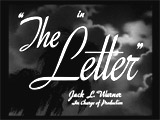




The Letter (1940), 95 minutes, D: William Wyler
Director William Wyler's superb melodrama from Warner Bros. was adapted from the 1927 W. Somerset Maugham play of the same name. The story was filmed once before as the silent The Letter (1929) with Jeanne Eagels, and remade as The Unfaithful (1947), starring Ann Sheridan. Director Wyler was again paired with actress Bette Davis, after their success with Jezebel (1938). On the grounds of a Malayan rubber plantation one evening, bored and restless wife Leslie Crosbie (Bette Davis) shot and point-blank killed old family friend Geoffrey Hammond (David Newell) on the porch and front steps of her home with her husband's gun - in the striking opening scene. She explained to her husband Robert (Herbert Marshall) (who was away on business at the time of the murder) and their hired respected lawyer Howard Joyce (James Stephenson), with cold calculation and manipulation, that it was self-defense to protect her honor. Her husband faithfully believed her. She claimed that Hammond, who was married to an Eurasian - Mrs. Hammond (Gale Sondergaard), had tried to rape her. She was to stand trial in Singapore for murder. [Note: In fact, she killed him because as her lover, he threatened to leave her to take another partner.] During the proceedings, clerk Ong Chi Seng (Victor Sen Yung) presented her lawyer Joyce with a copy of an incriminating letter written from murderess Leslie to Geoffrey on the day of the shooting, desperately asking to see him. The letter was in the possession of Hammond's widow, who blackmailed them by offering to sell it for $10,000 (all of Robert's savings). Leslie tearfully admitted her affair with Hammond. The letter had to be retrieved personally in a dramatic scene. During the subsequent court trial, Leslie was found innocent of murder charges, because the incriminating evidence wasn't produced. Leslie's lawyer told the jury it was "a simple, uncomplicated case" - after she again claimed she shot Hammond in self-defense. However, on the night of the acquittal in the film's conclusion, Leslie suffered a fateful retribution when she was knifed in the dark by Mrs. Hammond. According to the Hays Code, she had to pay and be punished for her indiscretion.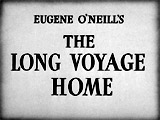

The Long Voyage Home (1940), 105 minutes, D: John Ford
Director John Ford's war drama was adapted from four short, one-act plays by Eugene O'Neill that were condensed into one screenplay. It included atmospheric, high-contrast, black and white cinematography by the famous Gregg Toland. This was Ford's first war film - and first WWII film (he later directed They Were Expendable (1945)). In a series of vignettes, set in pre-World War II year of 1939, the gripping film took a look at the lives and loves, hopes, dreams, and comradeship of working-class Merchant Marine seamen. Their British freighter, the S.S. Glencairn, was transporting dynamite in a dangerous mission-convoy from America to England, and was threatened by bad weather at sea, German U-boats and strafing plane attacks, the death of beloved crew member Yank (Ward Bond), and suspicions of treason against Smitty (Ian Hunter), one of the sailors. Young Swedish sailor and farm-boy Ole Olsen (John Wayne) was returning home to his mother's farm-home, with fellow seamate Aloysius Driscoll (Thomas Mitchell). An epilogue ended the film: "So men like Ole come and go, and the Driscolls live and die, and the Yanks and Smittys leave their memories - but for the others the Long Voyage never ends."

The Mark of Zorro (1940), 93 minutes, D: Rouben Mamoulian
Director Mamoulian's very popular, major B/W swashbuckling adventure story from 20th Century Fox was a remake of the silent costume-drama classic The Mark of Zorro (1920) with Douglas Fairbanks, Sr. It capitalized on the adventure tale craze perpetuated by other very popular Fairbanks' swashbucklers in the 1920s, including The Three Musketeers (1921), Robin Hood (1922), Don Q, Son of Zorro (1925), The Black Pirate (1926), and The Iron Mask (1929). Around the time of the success of The Adventures of Robin Hood (1938), there were also two routine, low-budget Republic Pictures serials: the 12-part Zorro Rides Again (1937) and Zorro's Fighting Legion (1939). Later, the Zorro tale became a 1957-1959 TV series (by Walt Disney) starring Guy Williams as Don Diego, and it was also remade as The Mask of Zorro (1998) and the follow-up The Legend of Zorro (2005), both with Antonio Banderas and Catherine Zeta-Jones. In this film's plot, cavalry officer Don Diego Vega (Tyrone Power), the son of an early 19th century S. California wealthy aristocrat Don Alejandro Vega (Montagu Love), returned home to Alta, California after a military academy education in Madrid, Spain (where he had been dubbed the "California cockerel" for his horsemanship and swordsman skills). He found that power had been usurped from his ex-Alcade father by corrupt oppressors led by the new Alcade, Don Luis Quintero (J. Edward Bromberg) and his tax-collecting henchman led by the lethal and evil Capt. Esteban Pasquale (Basil Rathbone). By day, nobleman-aristocrat Diego adopted the persona of a carefree, harmless, effeminate and foppish-looking fool or dandy (with a snuff box and lacy handkerchief), but at night he became a saving "Robin Hood" and/or "Scarlet Pimpernel" figure. He donned a black outfit, a mask and a sword, and as an outlaw, he rode on his black horse Tornado to avenge the tyrants, and to carve the letter Z into many surfaces to signify his name: Zorro. On the side, Diego flirted in response to the advances of Quintero's greedy wife Inez (Gale Sondergaard), causing some resentment by Pasquale who was also interested in her. Zorro's real love interest was provided by Quintero's pretty niece Lolita (Linda Darnell), who had prayed to the Virgin Mary for a handsome suitor: "Blessed Mother, send someone to take me from this dreary place. Someone I can love and respect. Let him be kind and brave. And... handsome, please, dear Mother." Her wish was fulfilled with Diego (as Zorro), although at first he was forced to cover his face and disguise himself as a monk. She became very distraught when she interacted with Diego as a "popinjay" and was forced to be bethrothed to him by her tyrannical uncle. As the film concluded, the cowardly-appearing Diego accepted Pasquale's taunting offer of a sword-duel, and they engaged in one of the best dueling scenes in cinematic history. As the swordplay climaxed, Diego pierced Pasquale with his sword, and as he fell, he dislodged a picture hung on the wall, revealing a carved "Z" - and his identity as Zorro. In the end after escaping from imprisonment, Zorro was able to rally the poor peasants, overthrow the cruel regime, marry Lolita, and reinstate Zorro's father as governor or Alcalde (leader of the community).

The Mortal Storm (1940), 100 minutes, D: Frank Borzage
Director Frank Borzage's propagandistic MGM melodrama was a flop at the box-office. It was based upon Phyllis Bottome's best-selling, pre-war 1938 novel, about ideological differences dividing up a family. The strong anti-fascist and anti-Semite message of the anti-Nazi film (one of the first Hollywood films of its kind, released a few months before Chaplin's The Great Dictator (1940)) caused it to be banned by the Aryan supremacist Nazis in Germany, led by Hitler's propaganda minister Joseph Goebbels. It told about the Roth family living idyllically and peacefully in the early 1930s in a small fictional Alpine village in Southern Germany - and the repercussions after Adolf Hitler came to power as Chancellor in the Third Reich in 1933 and Nazism slowly pervaded the country. The family was led by outspoken, respected, "non-Aryan" (or Jewish) 60 year-old teacher of biology Viktor Roth (Frank Morgan) at a Bavarian educational institution. Pretty daughter Freya Roth (Margaret Sullavan) was courted by young fascist Fritz Marberg (Robert Young), one of her father's students, but then rejected him in favor of more sensitive rival Martin Brietner (James Stewart), a long-time family friend, and Roth's protege as a pacifist veterinary student. Two Roth stepsons, Otto (Robert Stack) and Erich (William T. Orr), both supported the rise of Hitler and the Hitler Youth Organization, causing more friction and a rift in the family. When Professor Roth opposed the Nazi doctrines about racial segregation and a master race of Aryans, he was removed from his position, arrested and sent to a hard labor concentration camp, where he died under mysterious circumstances. In the grim conclusion, Martin aided Freya in an attempt to escape from Germany by crossing the border into Austria - by skiing through a mountainous snowy pass, where they were spotted by a Nazi platoon patrol led by Fritz. Although they were able to cross the border successfully, Freya was mortally wounded and died in Martin's arms.


My Favorite Wife (1940), 88 minutes, D: Garson Kanin
Director Kanin's classic marital screwball comedy featured the tagline: "The funniest, fastest honeymoon ever screened!" It had all the characteristics of screwball comedy - fast paced dialogue, absurd and wacky circumstances, and some slapstick. It was an attempt to repeat the success of director Leo McCarey's The Awful Truth (1937) (featuring the same two stars and producer McCarey). It was the second of three films which paired Cary Grant and Irene Dunne, followed by Penny Serenade (1941). It was to be remade as Something's Gotta Give (1962) with Marilyn Monroe (who died before completion), and officially remade as Move Over, Darling (1963) with Doris Day and James Garner. In the opening court scene, Judge Bryson (Granville Bates) declared that young 'widowed' attorney Nick Arden's (Cary Grant) wife of seven years, Ellen Wagstaff Arden (Irene Dunne), was presumed lost and declared legally dead after a seven year absence (and presumed drowned in the South Pacific Ocean during a typhoon). Immediately, Nick was allowed to remarry bride Bianca Bates (Gail Patrick). Suddenly and to everyone's surprise, Ellen reappeared at her home after seven years, where she spoke to her two young children who didn't know her, Tim (Scott Beckett) and Chinch (Mary Lou Harrington), and Nick's mother Ma (Ann Shoemaker). She learned it was the day of her husband Nick's remarriage to Bianca and their honeymoon night, spent at Yosemite Park lodge. As he entered an elevator in the lodge, Nick caught a surprise glimpse of his first wife Ellen in the lobby (tracking him down), supposedly legally dead - however, she had been rescued by a Portuguese freighter, and was trying to locate him (at the same locale where they had honeymooned seven years earlier). In a series of funny circumstances at the hotel, Nick tried to keep Ellen a secret from his second wife, by ordering a second room, Suite 'A' for her. After the honeymoon ended, Nick was having trouble telling the truth to Bianca ("My wife's come back"), and Ellen tormented and humiliated Nick and Bianca by pretending to be a Southern-accented, obnoxious visiting friend of the family. Soon, Nick became jealous when he learned that Ellen had not been alone on the desert island. She had been marooned with another survivor, handsome young scientist Stephen Burkett (Randolph Scott), who was discovered to be a virile, health-nut and athletic diver and pool swimmer at the posh Pacific Club. Nick was stunned - what was he to do, and what about the other man who may have compromised her? Ellen unsuccessfully tried to fool Nick by recruiting a mousy, bald-headed shoe salesman (Chester Clute) to claim that he was her "Adam" character while they were on the island. In the same courtroom from earlier, the Judge annulled Nick's second marriage, and Bianca punched Nick in the face. Although Ellen kept denying any fidelity, Nick kept believing that she had been unfaithful. In their mountain cabin, Ellen told her still non-committal husband Nick, who was sleeping in a separate bed, to think things over by taking a sixty-day cruise and coming back around Christmas-time. In the final scene in the cabin, Nick thought of a number of strategies to reconcile himself with Ellen. He returned dressed up as Santa Claus to join her in her bedroom rather than sleep separately in the attic, and pulled down his fake beard to wish her a "Merry Christmas!"
My Little Chickadee (1940), 83 minutes, D: Edward Cline
Edward Cline's western comedy marked the only film pairing both W.C. Fields and Mae West. It was filmed with the backdrop of the 1880s American West, and opened with Chicago singer Flower Belle Lee (Mae West) journeying westward to see her relatives in the town of Little Bend - her Aunt Lou (Ruth Donnelly) and Uncle John (Willard Robertson). During her stagecoach ride, a gold shipment was held up by a Zorro-like "Masked Bandit", and Flower Belle was abducted on horseback. She later had a nocturnal rendezvous with her kidnapper - and continued to romance him. As a result, Flower Belle was expelled from Little Bend by a judge (Addison Richards) for her indifference, sauciness and her illicit relationship. She was told she could return only if she was "respectable and married." On the train to Greasewood City, she met con-man Cuthbert J. Twillie (W. C. Fields). During an Indian attack on the train - with arrows whizzing by Flower Belle, she fired back with two six-shooters. Afterwards, believing he was rich after eyeing his bag full of money (it only contained phony oil-well coupons), Flower Belle accepted Twillie's proposal of marriage - with a roll of her eyes: "I'll take you, and how." They were married aboard the train in a phony sham ceremony officiated by one of the passengers Amos Budge (Donald Meek). In Greasewood City, Flower Belle insisted that they have separate rooms when they checked into the hotel. Due to his boasting and bravado, Twillie was made Sheriff by the corrupt town boss and saloon owner Jeff Badger (Joseph Calleia), who was competing for Flower Belle's love and knew that previous Sheriffs had suffered a high mortality rate. Flower Belle became the town's schoolteacher for a rowdy class of schoolboys. Twillie was frustrated in continued attempts to 'consummate' his marriage to Flower Belle, and once found himself making love to a goat in their bed. When Twillie was accused of being the Masked Bandit (a disguise he used to trick her and get into her boudoir) after an unfamiliar kiss with Flower Belle gave him away, he was strung up by a lynch mob and delivered his last wish: ("I'd like to see Paris before I die. Philadelphia will do"). When Flower Belle went to Badger to help rescue Twillie from death, she kissed him and realized he was the true Masked Bandit ("That man's kiss is like a signature"); Twillie was saved from hanging by Flower Belle's intervention (she shot at the noose-rope). It was also revealed to the townsfolk that Badger was the Masked Bandit, and Twillie was released. At the conclusion, Flower Belle told other possible suitors: "Any time you got nothin' to do and lots of time to do it, come up." Both of the main stars exchanged trademarked quips. Twillie delivered his last line to Flower Belle as he left town to go East to attend to his "hair" oil wells: "If you get up around the Grampian Hills, you must come up and see me sometime" (Mae West's signature line). She responded: "Aw, yeah, yeah, I'll do that, my little chickadee" (W.C. Fields' catchphrase). In the camera's last image -- as Flower Belle sashayed her bottom to ascend the stairs, the words "THE END" were super-imposed on her rear end.


Our Town (1940), 90 minutes, D: Sam Wood
Director Sam Wood's much-loved classic, dramatic story told about human life, love, tragedy and conflict. It featured a great musical score by composer Aaron Copland, and production design by William Cameron Menzies. It was an innovative filmed presentation of Thornton Wilder's 1938 Pulitzer Prize-winning play. In contrast to the play that was performed without scenery and only a few props, the film included realistic scenery - and a changed conclusion. The story was set in the simple, small New England town of Grover's Corners, NH, and was told in three sequences depicting the years before WWI (1901, 1904, and 1913). The film opened with a prologue given by the omnicient Stage Manager (Frank Craven), a guide who provided down-home commentary as the film's narrator, profiling the lives of the town's residents - he also served as the town's drugstore owner Mr. Morgan (Frank Craven). The plot was centered, in the first segment (in the year 1901), around young, pretty, bright, teenaged Emily Webb (Martha Scott, 25 years of age at the time of filming), the hard-working daughter of the town's newspaper editor Mr. Webb (Guy Kibbee) and his wife Julie (Fay Bainter). Emily fell in love with baseball-playing, 16 year-old high-school student George Gibbs (William Holden), son of the local doctor, Dr. Gibbs (Thomas Mitchell). They courted each other over a period of about three years. Then in the film's second segment (in the year 1904) about love and marriage, the two prepared to be wed. In the third segment (in the year 1913), set in the cemetery of Grover's Corners, it was told that Emily passed away during the childbirth for her second child. In a ghostly, in-between afterlife existence, Emily was given special permission to go back and re-live just one day of her life - the day of her 16th birthday (her 12th birthday in the play). Wearing white and often transparent in the company of others, she profoundly learned how the quiet, little, everyday, fleeting moments of life were precious - fast-moving and under-appreciated. In the twist ending epilogue (a severe modification from the play's original downbeat ending), Emily repetitively spoke: "I want to live" - she woke up from the temporary coma resulting from childbirth, and had survived the birth. She realized the film's third episode was just a dream or hallucination.

The Philadelphia Story (1940), 112 minutes, D: George Cukor
Director George Cukor's classic, sophisticated romantic comedy (with some screwball elements) was a witty and articulate adaptation of Phillip Barry's 1939 Broadway hit. Actress Katharine Hepburn financed the play (with additional support from Howard Hughes) that she would star in (with Joseph Cotten and Van Heflin) in 1939-1940, then picked the director, screenwriter, and other co-stars for the movie version. The film won a compensatory Best Actor-Oscar for James Stewart, and Best Adapted Screenplay. The film revived Hepburn's film career at the start of the 1940s, and erased her reputation as "box-office poison." The story was remade as a musical, High Society (1956) with Grace Kelly, Frank Sinatra and Bing Crosby. All of the action in the film occurred in the 24-hour period before the female protagonist's second wedding. Set amongst the upper class society in Philadelphia, a spoiled, intelligent, arrogant wealthy heiress, Tracy Samantha Lord (Katharine Hepburn) was about to be married, in a major societal wedding at the Lord's estate, to stuffy, self-important, executive millionaire George Kittredge (John Howard). Two years earlier, she had divorced her dashing, wealthy first husband C. K. Dexter Haven (Cary Grant) because he drank excessively and she was contemptuous of his irresponsible behavior. However, Dexter still loved Tracy and showed up in attendance at the wedding. Behind the scenes, Dexter had arranged for an exclusive, inside-story expose on the wedding to Spy magazine publisher Sidney Kidd (Henry Daniell), in exchange for preventing the publication of a second, scandalous expose about the womanizing reputation (an affair with a dancer) of Tracy's father Seth (John Halliday), his ex-in-law. (Tracy resented her father Seth for being estranged from her mother Margaret (Mary Nash), but also didn't want the family's reputation sullied.) Therefore, Dexter was able to allow the presence of two Spy Magazine employees at the pre-wedding festivities: sardonic, scandal-tabloid reporter Macauley ("Mike") Connor (Best Actor-winning James Stewart) and photographer Elizabeth ("Liz") Imbrie (Ruth Hussey), who was in love with Mike. Things became very complicated when the inquisitive, cynical reporter Connor began to fall in love (or infatuation) after becoming bedazzled by Tracy. A romantic triangle developed between Tracy and her three suitors: Kittredge, Mike, and Dexter. Mike expressed his romantic interest in her the evening before her marriage when he suggested that she shouldn't marry Kittredge, and shared a possibly-scandalous, but innocent moonlight swim with the slightly inebriated Tracy. The morning of the wedding ceremony, Tracy awoke with a hangover and no recollection of the previous night's escapades. A belligerent Kittredge was incensed after hearing and witnessing Tracy's compromised behavior when she was drunk. Sensing that Kittredge was also not a good match for her, Tracy called off her wedding to him, and also deflected Mike's interest in stepping forward as a new bridegroom. She ultimately decided to remarry Dexter and rekindle their past loving relationship.


Pinocchio (1940), 87 minutes, D: Ben Sharpsteen and Hamilton Luske and Disney
Walt Disney's second full-length animated feature film, a brilliant classic based on the children's story by Carlo Collodi, was a masterful, animated achievement. It was released the same year as Disney's Fantasia (1940). The charming storybook animated tale was narrated by a chirpy cricket named Jiminy Cricket (voice of Cliff Edwards), who served as the guiding conscience of the story ("Give a Little Whistle"). Although designed for youngsters, the animation included some truly frightening sequences. Jiminy opened the film by singing Oscar-winning Best Song "When You Wish Upon a Star." The plot (revealed by opening a fanciful storybook) told about a lonely, kindly, poor, toy shop puppetmaker and woodcutter Geppetto (voice of Christian Rub) who created an inquisitive marionette wooden boy named Pinocchio (voice of Dick Jones). Other companions were black-and-white kitten Figaro and Cleo the goldfish. His life-long wish was that Pinocchio would become a real boy. It came true by the interventions of a Blue Fairy in the workshop during the night, although the transformed alive boy was still made of wood. If he proved himself to be brave, truthful and unselfish (challenged by life's coming-of-age dangers), he would be changed into a real flesh-and-blood boy. Pinocchio quickly ran afoul on his way to school by associating with bad company, including the unforgettable characters of two devious con-crooks (J. Worthington Foulfellow (a sly fox) and his mute companion cat named Gideon), and was convinced to give up on schooling and pursue a life on stage ("Hi-Diddle-Dee-Dee (An Actor's Life for Me"). Pinocchio was introduced and sold to evil, Italian stage showman/puppet master Stromboli, where he performed on-stage in a puppet show with the song: "I've Got No Strings." In the evenings, Pinocchio was locked up in a birdcage to keep him imprisoned. Stromboli's objective was to tour with Pinocchio around the world and then chop him up into firewood. During another appearance of the Blue Fairy, Pinocchio lied about why he wasn't in school and his nose grew as he told more deceits - until it became as long as a tree branch where birds could perch. Pinocchio was given a second chance and freed. But again, Pinocchio was led astray by Foulfellow and Gideon, and transported by a "Coachman" to Pleasure Island (without rules or authority figures), where temptations abounded. Pinocchio and other young boys were encouraged to misbehave, gamble, drink, play pool, vandalize and smoke cigars. Pinocchio became friends with influential juvenile delinquent Lampwick, who due to his misbehavior, was transformed into a braying donkey (with ears, hooves, and a tail) as punishment for his bad behavior. He frantically cried out for his Momma - the donkeys were ultimately to be sold as slave-labor pack animals (jack-asses) in the salt mines or in circuses. Fearing for his own life when Pinocchio began to grow large ears and a tail, he was able to escape from the island with Jiminy's assistance. In the workshop, the two learned that Geppetto had gone looking for Pinocchio to rescue him, and on a raft-sailboat at sea, Geppetto was swallowed by the scary Monstro, the Whale, and was alive in Monstro's cavernous belly. Pinocchio managed to be swallowed to reunite with his father, and then schemed to light a fire inside the whale to force them to be expelled with a giant sneeze. They were propelled out of the whale's mouth, and escaped on their raft from the angry's whale's pursuit. The self-sacrificing Pinocchio saved his father from drowning, but ended up appearing dead on the shore. Back at home, Pinocchio was magically resurrected by the Blue Fairy for his good deeds, and rewarded for proving himself by being transformed into a real boy ("Awake, Pinocchio"). In the conclusion, Jiminy Cricket was also rewarded with a gold badge by the Blue Fairy for serving as Pinocchio's conscience.


Pride and Prejudice (1940), 117 minutes, D: Robert Z. Leonard
MGM's and director Robert Z. Leonard's dramatic, witty comedy (or parody) of manners, customs and morals of the aristocratic way of country life for the landed gentry in the early to mid-19th century pre-Victorian England, was adapted from Jane Austen's 1813 novel, with a screenplay partially written by author Aldous Huxley. It was lavishly produced as a period costume folly, and since has been remade many times, most notably Joe Wright's Pride & Prejudice (2005, UK) with Keira Knightley and Matthew Macfadyen. The central family was composed of Mr. and Mrs. Bennet (Edmund Gwenn and Mary Boland) who lived in a country farm home in Longbourn, and shopped and socialized while shopping in the village of Meryton. The parents, particularly the distressed, busybody and agitated Mrs. Bennet, were very anxious to marry off their five eligible but undoweried daughters - the eldest, overly-spirited, strong-willed, witty and opinionated Elizabeth (Greer Garson), lovely and gentle Jane (Maureen O'Sullivan), Lydia (Ann Rutherford), Kitty (Heather Angel), and Mary (Marsha Hunt). Each girl had her own peculiarities - flirtatious, silly, serious, bookish, plain, lovely, and gentle. In those days, girls were doomed to spinsterhood (and possible pennilessness) if they couldn't find an eligible man to marry and support them ("Look at them! Five of them without dowries"). And in particular, the Bennets could only pass on their fortune to their daughters through a male heir. The only sole heir at the present time was Mr. Bennet's distant cousin - boring and pompous Mr. Collins (Melville Cooper), who would obtain Longbourn if no male heir was produced. Fortunes looked favorable when some wealthy, eligible young bachelors rented the local Netherfield Park - a neighboring vast country house for the season, including Mr. Bingley (Bruce Lester) (and his sister Caroline Bingley (Frieda Inescort)) and their handsome but arrogant, boorish and condescending friend Mr. Darcy (Laurence Olivier). An opportunity for the daughters to meet the neighborhood's new residents occurred at the big social event - the Assembly Ball. Mr. Bingley courted Jane, while independent-minded Miss Elizabeth rejected Darcy's invitation to dance due to his prideful, mean and uncivil nature comments about the lowly middle-class, and specifically his treatment of one of the attendees, Mr. George Wickham (Edward Ashley), a boyhood friend of Darcy's. To spite Darcy for being harsh, Elizabeth accepted Wickham's dance request instead. Later, the shrewd Mrs. Bennet schemed to deliberately cause Jane to catch a bad cold when she encouraged her daughter to ride on horseback to Netherfield to attend a tea invitation. Jane was ordered by the doctor to remain for a week to recuperate, and Elizabeth was also sent to help her convalesce. Although Jane soon recovered and grew closer to Mr. Bingley, Elizabeth mostly was involved in an emotional stand-off against Mr. Darcy during her stay. Knowing that Elizabeth was failing with Mr. Darcy, Mrs. Bennet suggested that Elizabeth offer herself as a suitable wife for Mr. Collins - but she was aghast at the idea and spurned his company. Darcy noticed Elizabeth's distaste for Mr. Collins and helped her to avoid his pursuit after her through the garden during a gathering with the Bingleys at Netherfield. Elizabeth noticed and thanked Darcy for the assistance - and they began to develop a difficult but contrary romance. Later at the same garden party, Mrs. Bennet embarrassingly bragged about Jane's romantic success with Mr. Bingley ("Wasn't it clever of me to send her over in the rain? And, of course, dear Jane will see that the other girls have the opportunity of meeting all sorts of rich young men"). After the Bingleys departed from Netherfield to return to London, Jane received a note suggesting that Mr. Bingley was going to propose to Darcy's sister, instead of to her - and she was devastated by the news. Elizabeth's earlier opinions about Bingley and Darcy seemed to be confirmed and justified. Many months later, Elizabeth met again with Darcy while she was visiting her best friend Charlotte Lucas (Marjorie Wood) who had just become Mr. Collins' newly-wed wife. At Rosings - the estate home of wealthy Lady Catherine de Brough (Edna May Oliver), where Collins was employed by his "patroness," Elizabeth re-established a connection with Darcy, and he made a surprise proposal to her in condescending terms. (Moments before the marital proposal, Elizabeth heard that it was Darcy who had ruined her sister Jane's chances with Mr. Bingley.) Elizabeth refused his invitation to marry, and further berated him for his continued abusive treatment of people (including both Jane and earlier Mr. Wickham). Darcy quickly bid Elizabeth goodbye and left, and she returned to Longbourn. Now at home, Elizabeth learned that her unmarried 16 year-old sister Lydia had scandalously run away with Mr. Wickham. Darcy reappeared and revealed that Mr. Wickham had also run away with his 15 year-old sister Georgiana - illustrating to Elizabeth why Darcy hated Wickham so much. Lydia could not be found in London, and as the Bennet family prepared to leave Longbourn due to the family's disgrace, Mr. Wickham and Lydia arrived for a surprise homecoming and announced they had been married - and that he had received a major inheritance. The family's honor was thankfully restored. At the same time, however, the intimidating and haughty dowager Lady Catherine questioned Elizabeth's intentions to marry Darcy solely for his inheritance - she revealed that as Darcy's aunt (and trustee of his mother's estate), she could refuse to allow her nephew to marry Elizabeth. Although Elizabeth had no interest in marrying Darcy - due to her constant 'pride and prejudice' toward him - she was surprised to learn that Darcy still loved her. To her shock, she also realized that Darcy had been the one who provided Wickham with a paid income that allowed him to marry Lydia. All along, it seemed that Elizabeth had misread Darcy's character. Lady Catherine was made aware that Elizabeth was not a fortune hunter, and would be a good personality match for Darcy - and she told him: "She's right for you, Darcy. You were a spoiled child. But, we don't want to go on spoiling you! What you need is a woman who will stand up to you. I think you've found her!" The conclusion of the film found three of the Bennet sisters in love - Bingley who was now reconciled with Jane (due to Darcy's and Caroline's intervention), Lydia with her new beau Mr. Wickham, and Elizabeth reunited and in love with Darcy. The younger two Bennet daughters (Kitty and Mary) would be next, as Mrs. Bennet observed in the film's last lines: "Auhh! Think of it! Three of them married. And the other two, just tottering on the brink!"



Rebecca (1940), 130 minutes, D: Alfred Hitchcock
Alfred Hitchcock's debut American film - a winning Best Picture, was adapted from British writer Daphne du Maurier's 1938 novel of gothic romance and atmospheric intrigue - a compelling romance and murder mystery with intense psychological suspense. It also won the award for Best B/W Cinematography. The film opened with a voice-over flashback - a famous quote: "Last night I dreamt I went to Manderley again" - the burned-out ruins of the site (formerly an English country mansion) were viewed through dark tree foliage. The narrator then began to tell the story of "the strange days" of her life - in flashback. In the plot, after a rapid courtship following their first encounter in Monte Carlo, a shy, timid, naive, young unnamed woman became the second Mrs. de Winter (Joan Fontaine) by marrying a dashing, but brooding British aristocrat-nobleman 'Maxim' de Winter (Laurence Olivier), a haunted widower. The new wife was taken to live at his huge Manderley country mansion-estate in England, where she was continually reminded by the memories and shadow of Maxim's beautiful first wife, Rebecca, who died under mysterious circumstances. The icy-cold, sinister, creepy housekeeper Mrs. Danvers (Judith Anderson) taunted and frightened her, as did the other servants, while she continually heard praises and adoration for Maxim's former dead wife. Maxim was also somewhat surly, dispassionate toward his wife, and moody (due to his own feelings of guilt and sorrow), although later, he appeared to have been misunderstood. She began to helplessly misapprehend that Rebecca was a devoted, gracious and loving wife for Maxim, and continued to be a rival for her love for Maxim, although she was dead and gone. At one point, Mrs. Danvers even went so far as to encourage the second Mrs. de Winter to commit suicide by jumping from a window. The near-suicide was interrupted by sirens signaling the discovery of a boat-wreck. The untold secrets of the past were slowly unraveled when the remnants of Rebecca's intentionally-sunken boat washed ashore. Her drowned remains were inside the boat, that had been sabotaged with holes. Mr. de Winter confessed to his surprised wife that Rebecca had forever tormented him in a love-hate relationship, with her cleverly manipulative nature and promiscuity. The ending revealed important findings: (1) Rebecca was not pregnant with another man's child, but terminally ill with inoperable cancer, (2) Rebecca intended to goad Maxim into killing her in the boat house, (3) when Maxim wouldn't kill her as she wished, she planned to commit suicide, but fell and hit her head on some boat tackle in the beachside boat house. (4) Maxim covered up her accidental death by putting her in a boat and deliberately sinking it. An inquest into the case eventually cleared Maxim from any wrong-doing. The second Mrs. de Winter was finally freed from her fears and uneasiness. When Maxim returned home from London to Manderley, he found that the deranged and malevolent Mrs. Danvers had suicidally burned down the estate - and consumed (literally) the haunting memories of the past. The staff and the second Mrs. de Winter escaped from the blaze, but Danvers deliberately perished in the flames in Rebecca's old bedroom.



Santa Fe Trail (1940), 110 minutes, D: Michael Curtiz
Director Michael Curtiz's action-filled, but historically-inaccurate western-adventure tale from WB Studios, was actually misnamed. This was the seventh of nine movies co-starring the romantic coupling of Olivia de Havilland and Errol Flynn. The film followed the military life of the future great Confederate general, Virginian Jeb Stuart (Errol Flynn). He began his military career as a West Point student, where he had a strong friendship with George Armstrong Custer (Ronald Reagan) (completely inaccurate historically), and other future military leaders. There, rival cadet Rader (Van Heflin), who supported fanatical abolitionist activities, was dismissed for agitation - their paths would cross again later. Cavalry officer Jeb was assigned to a Kansas post (Ft. Leavenworth) with other Point graduates, to keep the peace (due to a war over whether Kansas would be slave or free) and quell any uprisings. On the train to Kansas, Stuart met and began a romance with 'Kit Carson' Holliday (Olivia de Havilland), whom he would eventually marry. The film ended with Stuart capturing fanatical abolitionist John Brown (Raymond Massey) at the Harper's Ferry arsenal at the Maryland-Virginia border, leading to the lunatic agitator's hanging.


The Sea Hawk (1940), 109 minutes, D: Michael Curtiz
Director Michael Curtiz's exciting and spirited swashbuckler (with great swordplay and sea battles) and escapist film was one of the best of its kind. It was adapted from the 1915 novel by Rafael Sabatini, and featured a tremendously rousing score by Erich Wolfgang Korngold. [Note: Sabatini was also the author of the 1921 novel Scaramouche which was made into an MGM film in 1952 with Stewart Granger).] This film solidified the image of star Errol Flynn as a dashing action character (after his appearance in Michael Curtiz' earlier film Captain Blood (1935), also from another Sabatini novel written in 1922). The action-film opened in Spain in the year 1585 as the imperialistic, gray-bearded Spanish King Phillip II (Montagu Love) announced his intentions to rule the world (and England). He was impatient that his Armada was not ready to invade England and stop its plundering of Spanish wealth. The King sent his crafty Spanish Ambassador Don José Alvarez de Cordoba (Claude Rains) (accompanied by his beautiful niece Doña María (Brenda Marshall)) to England to speak to the Queen. During their voyage, the dashing, but gentlemanly swashbuckling privateer, British sea Captain Geoffrey Thorpe (Errol Flynn), "the Sea Hawk" (more accurately, a "Sea Dog") on his ship the Albatross attack the Spanish ship en route to England. After sinking the Spanish vessel, Thorpe escorted the diplomat and his argumentative niece to England to meet with the Queen. Meanwhile in England, Queen Elizabeth I (Flora Robson) was being advised to prepare for England's defense by building a fleet of ships to repel the Spanish threat (and their Armada). One of the Queen's advisors-ministers was roguish Councilor Lord Wolfingham (Henry Daniell), a suspicious "fifth columnist" who was secretly collaborating with the Spanish. The Queen secretly commissioned and sanctioned the activities of buccaneer pirates - such as Thorpe, to contribute plunder to the English Treasury's coffers. She gave him her blessing to Thorpe to proceed with his plan to attack Spain's New World treasured "gold fleet" (with a year's plunder in gold) that would be leaving Panama bound for Spain within three months. His plan was to head for the Isthmus of Panama and land, to engage in a secret jungle raid upon Spain's treasure hunters along a Central American mule train gold route. Before Thorpe departed, he met with Dona Maria in the Queen's palace gardens where they obviously were falling in love with each other. In the swampy Panamanian jungle, Thorpe and his men were ambushed, eventually captured and taken prisoner back to Spain to face the Inquisition. The group was sentenced for life as galley slaves aboard a Spanish galleon slave ship. During his time as a slave, the news of the plot of the Spanish to imminently attack with their newly-built Armada and aggressively invade England was passed to Thorpe. He discovered that secret documents about the Armada from King Phillip were being transferred and taken to London, to be delivered to Spain's traitorous spy Lord Wolfingham. This inspired Thorpe and his men to commit mutiny, seize the secret dispatches from Phillip to Wolfingham as evidence that Spain's war plan was real, and inform the Queen. The film concluded with Thorpe's successful return to England, his defeat and murder of Wolfingham during a climactic sword-duel, and his delivery of the dispatches to the Queen that divulged the entire Spanish plot of treachery against England with the Armada. As the film ended, England was saved, Thorpe was reunited with his love Dona Maria, and rewarded by being recognized by the Queen as a Knight of the Realm on board the Albatross. The Queen vowed to her subjects and nation that she would rebuild England's fleet to defend the nation.


The Shop Around the Corner (1940), 97 minutes, D: Ernst Lubitsch
Director Ernst Lubitsch's brilliant and charming romantic comedy was about everyday people in a "shop around the corner," with all the right elements (the common plot of deception and mistaken identities in a love-hate relationship) - to create the right "Lubitsch touch." It was remade as a musical, In the Good Old Summertime (1949) with Judy Garland and Van Johnson, and as the 1963 Broadway play She Loves Me that was also a BBC-TV movie in 1979. Later, it became the updated You've Got Mail (1998) with Tom Hanks and Meg Ryan. In the story, the head sales clerk of a Budapest notions/gift shop, Matuschek and Company (owned by autocrat Hugo Matuschek (Frank Morgan) and Pirovitch (Felix Bressart)), was bookish bachelor Alfred Kralik (James Stewart). Alfred worked along side newly-hired shopgirl Klara Novak (Margaret Sullavan). The two clerks mutually disliked each other and bickered constantly. The two hostile sales-persons were unaware that they had become each other's anonymous pen pals writing each other very literate correspondence. On paper, they were romantically compatible, and corresponded with affectionate "lonely-hearts" letters. On the same night that the two pen pals agreed to meet at a cafe, Alfred was fired by his employer Matuschek when wrongly suspected of having an affair with his wife. [Note: The real culprit was later determined to be Vadas (Joseph Schildkraut).] Alfred sought solace with his pen-pal sweetheart, in a memorable sequence, but didn't reveal his identity as her pen-pal, stringing her along. Soon after, Alfred was rehired, given a raise, and promoted to manager - infuriating Klara. She was upset that her pen pal hadn't kept his appointment, and that she must now work under Alfred. In the inevitable happy conclusion set on Christmas Eve, Alfred finally revealed his identity to Klara when the two were left alone in the shop after a busy and profitable day. He mentioned "Box 237," tipping her off to the fact that he was her "dear friend" and correspondent.




The Thief of Bagdad (1940, UK), 106 minutes, D: Ludwig Berger, Michael Powell and Tim Whelan, produced by Alexander Korda
Subtitled: An Arabian Fantasy, this fanciful film was a remake of the earlier magical silent film The Thief of Bagdad (1924) starring Douglas Fairbanks, Sr., and was later remade as The Thief of Bagdad (1961, It.) with Steve Reeves. Disney's animated Aladdin (1992) heavily borrowed from this version as well. It became one of the best, most enchanting fantasies ever made - with an Arabian Nights theme, including spectacular special effects (a mechanical horse, a huge spider, an All-Seeing Eye (ruby jewel), the 6-armed Silver Maid statue, etc.), amazing Technicolor photography, a memorable musical score, and wonderful performances. The film's story began, in flashback, as told by an elderly and deposed blind King Ahmad (John Justin) of the city of Bagdad, now a beggar. He explained how he was tricked out of his kingdom by an oppressive, black-clad, evil magician-sorcerer named Jaffar (Conrad Veidt), his treacherous Grand Vizier. A mischievous young urchin named Abu (15 year-old Sabu), who was thrown in a dungeon for theft, helped the good-hearted, Prince Ahmad escape. In the city of Basra, he fell in love (at first sight) with the toy-obsessed Sultan's (Miles Malleson) pretty daughter, the Princess (June Duprez). Unfortunately, the two were captured - Ahmad was blinded, while Abu was magically turned into Ahmad's seeing-eye dog by a black magician. The two were promised they would be restored if they rescued the Princess. In the end, they saved Ahmad's kingdom and throne and his love. Abu and Ahmad were helped by a giant yet jovial genie Djinni (Rex Ingram) who emerged in black smoke from a bottle, and possessed a magical flying carpet.


Waterloo Bridge (1940), 109 minutes, D: Mervyn LeRoy
Director Mervyn LeRoy's classic, sentimental, romantic tearjerker was Vivien Leigh's first film following her success in Gone With The Wind (1939). In the plot, middle-aged British colonel Roy Cronin (Robert Taylor) paced on the famous Waterloo Bridge in the city of London during World War II - he was again readied to be deployed to the war front in France. As he stood on the bridge and pulled out of his coat a keepsake (good-luck charm) and symbol of a long-lost love of his life, he reminisced about the same setting years earlier in 1914 when he was a handsome young Army captain. In flashback, he remembered when he was about to depart for the trenches. He recalled during an air raid how he had retrieved the dropped purse and lucky charm of 19 year-old Myra Lester (Vivien Leigh), a naive and virginal ballet dancer, and helped her to an underground station shelter. As they parted after an all-clear was announced, she gave him her good-luck charm. The two met for dinner and waltzed in candlelight in the Candlelight Club to the tune of "Auld Lang Syne" as groups of musicians extinguished their lights - and they experienced their first kiss. He was called off to war, but his departure was delayed by two days and he and Myra met again the next late morning, when he impetuously insisted on marrying Myra. But then when Roy's orders were again changed, their plans to wed had to be postponed. Bidding him farewell at the Waterloo train station, she abandoned her dance performance and was subsequently fired from her ballet school troupe by Madame Olga Kirowa (Maria Ouspenskaya), the tyrannical mistress. Desperate, Myra soon descended into poverty with her best friend/roommate Kitty (Virginia Field), and became destitute. Kitty secretly turned to prostitution, walking the Waterloo Bridge for clients. Soon after, Myra falsely learned that Roy had been killed in the war. Heartbroken and poverty-stricken, Myra decided to join Kitty and also became a street-walker and was soon picking up male clients on the Waterloo Bridge. In a memorable scene, Myra accidentally met Roy when he returned about a year later at the London train station, while she was soliciting business from returning soldiers. He had only been injured with a head wound and became a German prison-camp POW. During their reunion, Myra didn't reveal her occupation to him, and pretended that she was there to greet a friend. She was overwhelmed by his warm welcome, and they renewed their romance and lives. Myra soon realized that her deceptive ploys would not work, and would only bring shame to Roy's family and his rich, socially-conscious, aristocratic mother Lady Margaret Cronin (Lucile Watson). She became distraught and suicidal, feeling degraded by her indiscretions and deception, and fearing that her secrets would resurface and prevent them from marrying. Myra left a farewell note for Roy. Afterwards in London, Myra's friend Kitty revealed the reality of Myra's nightlife to a disbelieving Roy by taking him through one seedy bar after another. In the film's most tragic and downbeat scene on a foggy night, the impoverished and depressed Myra eluded Roy and deliberately walked into oncoming traffic on Waterloo Bridge, where she was struck and killed by a truck; the good-luck charm fell from her hand onto the pavement. The film returned to the beginning, as General Roy Cronin was on the bridge and clutching Myra's good-luck charm before leaving for the front. In his memory years later, he tearfully recalled her earlier words in the film's final melodramatic moments.

The Westerner (1940), 100 minutes, D: William Wyler
Director William Wyler's entertaining western saga starred Walter Brennan (who won a record-setting third Academy Award for his supporting role) and Gary Cooper. The story was told in the era of vicious range wars between cattlemen and homesteaders in the post-Civil War period, and included an impressive Gregg Toland-filmed prairie fire sequence. In the main plot set in 1882, drifter cowboy and saddle tramp Cole Harden (Gary Cooper), on his way through Texas to California, rode into Vinegaroon, TX (later renamed Langtry) run by notorious, self-appointed, despotic hanging Judge Roy Bean (Walter Brennan), who called himself "the Law west of the Pecos." Hardin was falsely accused of stealing a horse (claimed to be owned by the Judge's sidekick Chickenfoot (Paul Hurst)) after buying a horse from a horse thief (Tom Tyler) and was taken before the infamous justice of the peace for a mock trial, and sentenced to hang. He talked his way out of being hanged by convincing the judge of his friendship with the obsessive judge's idol, English stage star Lily Langtry (Lilian Bond). Later, he gave the judge a lock of her hair, convincing him it was real, although he had cut the lock from the head of homesteader Jane-Ellen Mathews (Doris Davenport). The real horse thief was ultimately identified and killed. Harden ended up defending homesteaders on the opposite side from the judge in a bloody and violent range war and land dispute. In the final showdown and shootout scene, Harden confronted the judge in a gas-lit opera theatre in Ft. Davis, TX with guns drawn before a Langtry performance. When the theater curtain opened, it revealed the deputized Harden standing on stage and ready for a gunfight with Judge Bean (the sole audience member) rather than a performance by British actress Lily Langtry (Lilian Bond) - 'the famous Jersey Lily.' The Judge was lethally wounded during a brief gunfight. Backstage, the dying Judge was wide-eyed as he glimpsed the fantasy woman of his life; she blurred in his vision as he fell dead.